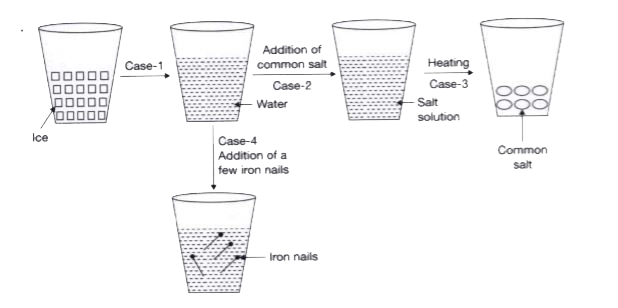Aluminium metal melts at 660∘C and burns in oxygen to form aluminium oxide. Identify the physical and chemical properties and changes involved in the above statement.
To identify the physical and chemical properties and changes involved in the statement "Aluminium metal melts at 660°C and burns in oxygen to form aluminium oxide," we can break it down into steps.
1. Identify the Physical Change:
- When aluminium metal is heated to 660°C, it undergoes a change in state from solid to liquid. This process is known as melting.
- Physical Change: Melting of aluminium from solid to liquid.
2. Identify the Physical Property:
- The melting point of aluminium is a characteristic property that can be observed and measured.
- Physical Property: Melting point of aluminium = 660°C.
3. Identify the Chemical Change:
- When aluminium burns in oxygen, it reacts to form a new substance, aluminium oxide. This process involves a chemical reaction where the original substance (aluminium) is transformed into a different substance (aluminium oxide).
- Chemical Change: Formation of aluminium oxide when aluminium burns in oxygen.
4. Identify the Chemical Property:
- The ability of aluminium to react with oxygen is a characteristic property that describes how it behaves chemically.
- Chemical Property: Reaction of aluminium with oxygen to form aluminium oxide.
Summary of Findings:
- Physical Change: Melting of aluminium.
- Physical Property: Melting point = 660°C.
- Chemical Change: Formation of aluminium oxide.
- Chemical Property: Reaction with oxygen.
- When aluminium metal is heated to 660°C, it undergoes a change in state from solid to liquid. This process is known as melting.
- Physical Change: Melting of aluminium from solid to liquid.
- The melting point of aluminium is a characteristic property that can be observed and measured.
- Physical Property: Melting point of aluminium = 660°C.
- When aluminium burns in oxygen, it reacts to form a new substance, aluminium oxide. This process involves a chemical reaction where the original substance (aluminium) is transformed into a different substance (aluminium oxide).
- Chemical Change: Formation of aluminium oxide when aluminium burns in oxygen.
- The ability of aluminium to react with oxygen is a characteristic property that describes how it behaves chemically.
- Chemical Property: Reaction of aluminium with oxygen to form aluminium oxide.
- Physical Change: Melting of aluminium.
- Physical Property: Melting point = 660°C.
- Chemical Change: Formation of aluminium oxide.
- Chemical Property: Reaction with oxygen.
Topper's Solved these Questions
- BOOK - MTG IIT JEE FOUNDATIONCHAPTER - IS MATTER AROUND US PURE ?EXERCISE - EXERCISE (LONG ANSWER TYPE )5videos
IS MATTER AROUND US PURE ?
- BOOK - MTG IIT JEE FOUNDATIONCHAPTER - IS MATTER AROUND US PURE ?EXERCISE - EXERCISE (INTEGER / NUMERICAL VALUE TYPE )5videos
IS MATTER AROUND US PURE ?
- BOOK - MTG IIT JEE FOUNDATIONCHAPTER - IS MATTER AROUND US PURE ?EXERCISE - EXERCISE (SUBJECTIVE PROBLEMS -VERY SHORT ANSWER TYPE )17videos
IS MATTER AROUND US PURE ?
- BOOK - MTG IIT JEE FOUNDATIONCHAPTER - FOOTSTEPS TOWARDS(CBSE BOARD)EXERCISE - SECTION-D14videos
FOOTSTEPS TOWARDS(CBSE BOARD)
- BOOK - MTG IIT JEE FOUNDATIONCHAPTER - MATTER IN OUR SURROUNDINGS EXERCISE - OLYMPIAD/HOTS CORNER15videos
MATTER IN OUR SURROUNDINGS
Similar Questions
Knowledge Check
- Question 1 - Select One
On burning______reacts with oxygen to produce metal oxides that are ____in nature the information in which row completes the given statement?
Ai-metals,ii-acidicBi-non metal ,ii-acidicCi-metals,ii-basicDi-nonmetal,ii-basic
Identify the following as either a physical or a chemical property.
Cooking gas burns in air to give a flame.View SolutionWhen a candle burns, both physical and chemical changes take place. Identify these changes.
View SolutionIdentify the following as either a physical or a chemical property.
Water freezes at 0∘C.View SolutionIdentify the following as either a physical or a chemical property.
Ice melts when kept outside the fridge.View Solution(a) What is a balanced chemical equation ? Why should chemical equations be balanced ?
(b) Aluminium burns in chlorine to from aluminium chloride (AlCl3). Write a balanced chemical equation for this reaction.
(c ) Fotassium metal reacts with water to give potassium hydroxide and hydrogen gas. Write a balanced chemical equation for this reactionView SolutionAn element 'X' (Atomic number = 20) burns in the presence of oxygen to form a basic oxide.
(a) Identify the element and write its electronic configuration. (b) State its group number and period number in the Modern Periodic Table. (c) Write a balanced chemical equation for the reaction when this oxide is dissolved in water.View SolutionClassify the changes involved in the following processes as physical or chemical changes:
Burning of coalView Solution


